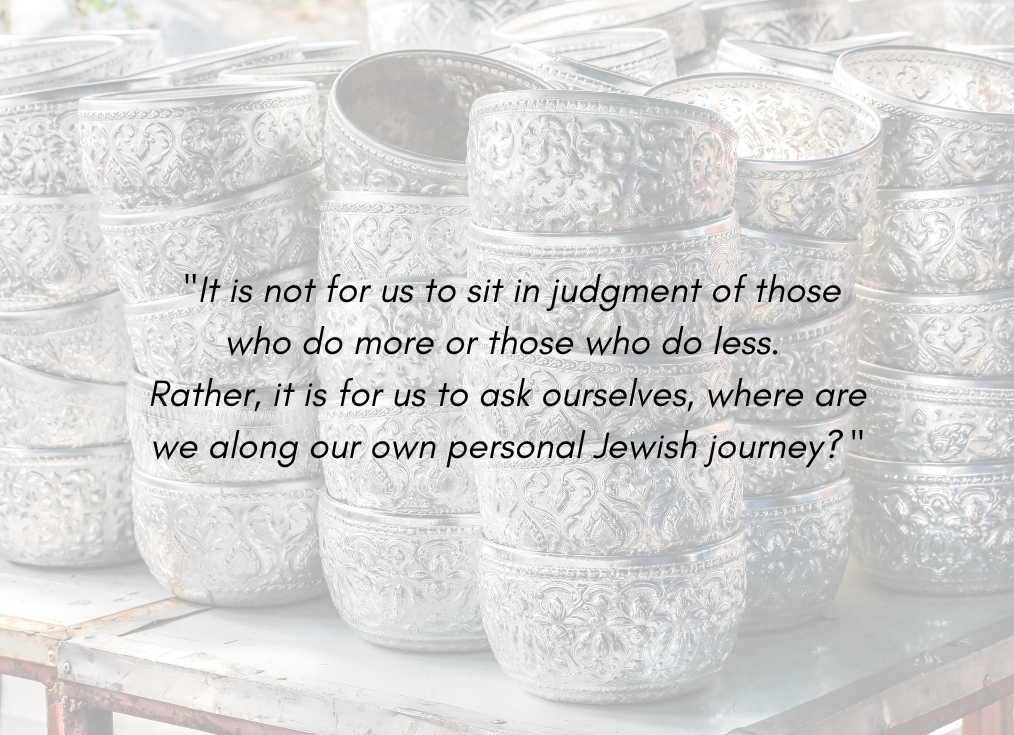Unique Gifts

June 2, 2023 / 13 Sivan 5783
This week’s Torah portion, Naso, is the longest individual weekly reading in the bible. However, having been a religious school administrator and middle school teacher, “longest” doesn’t necessarily mean “hardest,” especially when it comes to this particular reading.
Yes, it is true, that at 176 verses long, Naso is, in fact, the longest reading in the Torah, but as was the case in my classroom so many years ago, when one student claimed he had the hardest portion because he was assigned Naso, the longest, his classmates soon rebelled and quickly proved him wrong because of the relentless repetition in chapter 7:
“…one silver bowl weighing 130 shekels and one silver basin of 70 shekels by the sanctuary weight, both filled with choice flour with oil mixed in, for a meal offering; one gold ladle of 10 shekels, filled with incense; one bull of the herd, one ram, and one lamb in its first year, for a burnt offering; one goat for a sin offering; and for his sacrifice of well-being: two oxen, five rams, five he-goats, and five yearling lambs.” (verses: 12-17; 19-23; 25-29; 31-35; 37-41; 43-47; 49-53; 55-59; 61-65; 67-71; 73-77; 79-83)
Now, to provide some context for the above laundry list of offerings, these were the gifts that each head of the twelve tribes brought forth “On the day that Moses finished setting up the Tabernacle…” (Numbers 7:1) Twelve times the above verses were repeated verbatim. Twelve times we get to read the list of silver bowls and golden ladles, of choice flour and meal offerings, and of goats and oxen, and rams, and yearling lambs.
…
What is so strange, and what our great sages discuss, is why does the Torah repeat the exact same information when we know that every word carries great significance and has very specific meaning and purpose? The above would seem like a perfect time to list the offerings one time, followed by listing the names of each tribal chieftain who brought forth the gifts on behalf of their tribe.
In Midrash Bamidbar Rabbah 13:13, the rabbis confront this dilemma and explain that although the gifts were identical, the meaning and significance of each one was distinct and personal, and so Gd included each list separately because they were, in fact, very unique.
The lessons to be learned from this week’s Torah portion remind me of my time in the classroom teaching math. “Remember to show your work” was an oft-repeated mantra. Without showing their work, I could not tell if a student was right because of a lucky guess or if they understood the concept. Similarly, was the student wrong because of a silly calculation error or because they did not understand the theory behind the problem? The result is important, but how we get there is equal, if not more important.
It can be said that how we live our lives, and the reasons behind why we make the decisions we make, will be judged by Gd the same way. There is a story about the Chassidic Master, Zusia. As he lay on his deathbed, his students witnessed him crying. In turn, they asked, “Reb Zusia, why are you so sad? You have lived a life equal to the greatest heroes of our past.”
Zusia responded to his students with tears in his eyes, “When I cross over and go to heaven, Gd will not ask me why I wasn’t as righteous as the great prophet Moses or as wise a leader as the great King Solomon. No, Gd will ask, ‘Why were you not more like Zusia?’”
Each of us was born with our own unique talents, skills, and abilities. Each of us was born with a personal connection to our Jewish heritage, community, and personal ideology. It is not for us to sit in judgment of those who do more, or those who do less. Rather, it is for us to ask ourselves, where are we along our own personal Jewish journey? If we are to look at another, it should be so that we can be a support, a resource, a guide on the side… not a sage on the stage! Because we are…
STRONGER TOGETHER.
Shabbat Shalom,

